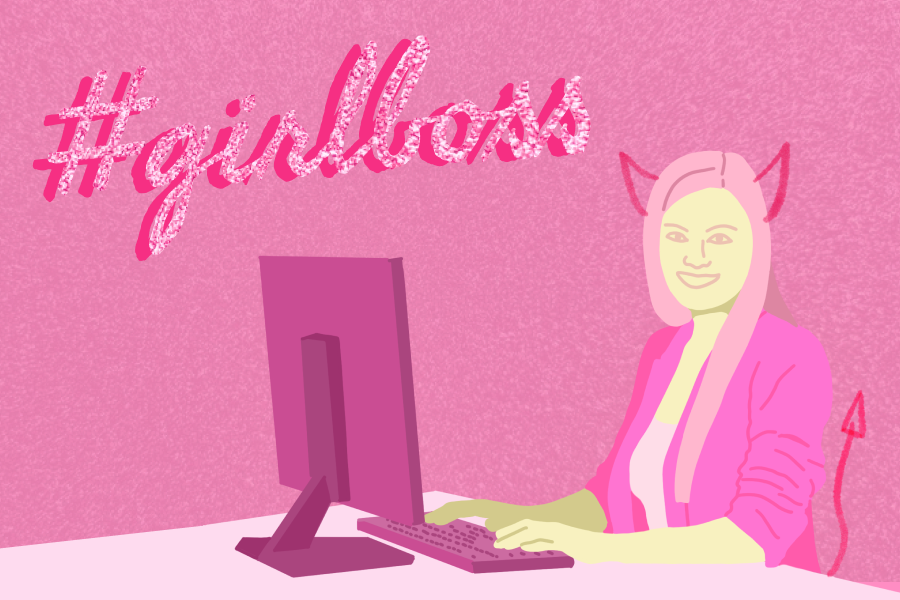
Breaking down the facade of the girlboss movement
At this point you’d have to be living under a rock to have not heard or seen the term girlboss being used in some way—whether satirically or (god forbid) genuinely. While the term first gained popularity on the internet by the eBay clothes-flipper turned fast fashion company owner, Sophia Amoruso, girlboss has morphed into so many different things, with many people not even knowing all the connotations it carries.
After creating the clothing brand Nastygal, Amoruso went on to release a memoir aptly titled #GIRLBOSS, and later had an entire Netflix limited series dedicated to her story called, you guessed it, “Girlboss.” Being the one who first coined this viral term, as well as the founder of one of the most environmentally and ethically harmful fashion companies out there right now, Amoruso is the perfect example of what a girlboss really is.
#Girlboss is a facet of that brand of neo-liberal feminism that tells us to cheer on any woman just because she’s doing something—don’t ask exactly what she’s doing, who is benefitting or why we are celebrating the bare minimum. A girlboss is a woman in a position of power (something we should all immediately assume is inherently a man’s place, of course) whether that be in a leading position in a huge company, politics or even Hollywood. The main idea here is to not think too deeply about what’s going on, and just be grateful that they’re letting a woman do these big, important jobs.
Besides Amoruso, one major girlboss that comes to mind is our current Vice President, Kamala Harris. Yes, she broke countless glass ceilings being the first woman vice president, not to mention the first woman of color in the office, but we have to remember that she is in fact more than just “Madam Vice President.” In her career as a district attorney as well as Attorney General of California, Harris has outright worked against progressive criminal justice reforms and strongly opposed steps to decriminalize recreational marijuana and protect sex workers. The self-proclaimed “top cop” has since backtracked many of the firm stances she held for years as a prosecutor, but has yet to put her newly progressive views into action.
This is a quintessential aspect of the glorious girlboss—as Harris does, a true girlboss must declare their undying loyalty to the feminist cause and universal liberation from the patriarchy, but she must also fit ever so comfortably in her throne provided by the establishments she claims to despise. The most glaring example of this girlboss hypocrisy is in Harris’ declaration as a strong ally of the LGBTQ+ community, reminding us all of the times she officiated same-sex marriages herself in San Francisco in 2013, while in 2015 as the Attorney General, she blocked the request of an incarcerated trans woman (who was being kept in a men’s prison) to receive gender-affirming surgery. These are not very #girlboss moments … or is that exactly what a girlboss is? Is she simply the perfect mechanism to maintain the status quo while providing the illusion of progress?
Harris is definitely not the only prominent girlboss of today, as she shares the title with many other women in politics, as well as celebrities, breaking glass ceilings while steadily maintaining much less breakable boundaries. There’s the Academy Award-nominated director Greta Gerwig, who notoriously creates films in which the only race is white, Gwyneth Paltrow, aka the health and lifestyle guru/scammer targeted exclusively to the highest of the upper class, and lest we forget, the queen of toxic “feminism,” Jameela Jamil.
While the deeper reasons behind why the girlboss prototype has become ever so prevalent in our world might be pretty complex, and albeit sinister, it’s actually really simple to see the essentially surface-level issue with the term itself. Girlboss as a title is extremely patronizing, even without all the real-world context. As we’ve seen, giving someone the title of girlboss implies she is a ‘boss’ despite being a girl, as if that is what has been prohibiting women from climbing the ladder in so many professions all these years, and not misogyny. To make this crystal clear, I’ll ask, where are all the “boybosses”? That answer is too easy, the boy bosses are simply the bosses. A man in power is still supposed to be the norm, and girlboss does nothing to refute this entirely outdated claim—it only gives women who somehow manage to reach the level of ‘boss’ a nice little pink badge of honor.
Written by: Angie Cummings — arts@theaggie.org
"really" - Google News
May 10, 2021 at 11:31PM
https://ift.tt/3tBGgVg
#Girlboss—but who's really in charge? - The Aggie
"really" - Google News
https://ift.tt/3b3YJ3H
https://ift.tt/35qAk7d
Bagikan Berita Ini














0 Response to "#Girlboss—but who's really in charge? - The Aggie"
Post a Comment